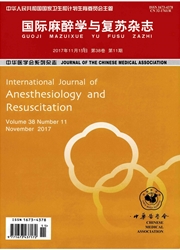

 中文摘要:
中文摘要:
目的探讨脊髓水平肿瘤坏死因子-α(TNF—α)在小鼠骨癌痛中的作用。方法48只C3H/He小鼠随机分为肿瘤组和假手术组,每组再次划分为术后7d、10d、14d组(n=8)。将含10^3个纤维肉瘤NCTC2472细胞的最小必需培养基(α-MEM)注射到小鼠右侧股骨远端骨髓腔内,制作骨癌痛模型。假手术组注入不含肿瘤细胞的α-MEM。按照分组在相应时间点处死小鼠,用RT—PCR的方法检测脊髓腰膨大TNF-α mRNA水平,观察术前、术后3d、5d、7d、10d、14d小鼠痛行为学的变化:机械痛缩足阈值(paw withdrawal mechanical threshold,PWMT)、热痛缩足潜伏期(paw withdrawal thermal latency,PWTL)和自发性抬足次数。结果肿瘤细胞接种后,在各观察时间点,肿瘤组脊髓水平TNF-α mRNA表达较假手术组增高(P〈0.05)并伴随痛觉过敏。结论脊髓水平TNF-α在骨癌痛的发生机制中起作用。
 英文摘要:
英文摘要:
Objective To explore the role of tumor necrosis factor-α (TNF-α) in spinal cord in the development of mouse bone cancer pain. Methods Forty eight C3H/He mice were divided randomly into tumor group and sham group. Each group was further divided into three subgroups according to the time-points at 7th, 10th and 14th post-inoculating day (n= 8). Osteosarcoma NCTC 2472 cells were implanted into the intramedullary space of right femur to make model of bone cancer pain. The sham group was inoculated with α-MEM containing no cell. Inoculated mice were killed according to the corresponding time-points. Reverse transcriptive polymerase chain reaction(RT-PCR)was applied to analysis the expression of TNF -α mRNA in spinal cord. Changes in pain behaviors including paw withdrawal mechanical threshold (PWMT)and paw withdrawal thermal latency (PWTL) were observed before inoculation and at 3rd, 5th, 7th, 10th and 14th post-inoculating day. Results After inoculation, coupled with pain aggravation, mRNA of TNF-α in spinal cord of tumor mice increased at each time-point (P〈0.05). Conclusion TNF-α in spinal cord may participate in bone cancer pain.
 同期刊论文项目
同期刊论文项目
 同项目期刊论文
同项目期刊论文
 Intrathecal Administration of the Cannabinoid 2 Receptor Agonist JWH015 Can Attenuate Cancer Pain an
Intrathecal Administration of the Cannabinoid 2 Receptor Agonist JWH015 Can Attenuate Cancer Pain an The respective and interaction effects of spinal GRs and MRs on radicular pain induced by chronic co
The respective and interaction effects of spinal GRs and MRs on radicular pain induced by chronic co 期刊信息
期刊信息
